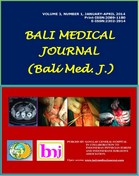NON NEUROLOGICAL OUTCOME COMPARISON OF EARLY AND DELAYED SURGICAL STABILIZATION IN C-SPINE FRACTURES
Abstract
Background: Non neurological outcome postsurgical stabilization in C-spine injury has not been reported. Non neurological outcome i.e. the risk of lung infection (pneumonia), systemic inflammation response syndrome (SIRS), length of postoperative care (LOPOC) which can compromise the recovery process and treatment period. This study aims to investigate non neurological outcome comparison after early surgical stabilization (ESS) and delayed surgical stabilization (DSS) in patients with C-spine fractures. Methods: The author retrospectively reviews 59 of 108 consecutive patients who met the inclusion criteria with C-spine fractures who underwent surgical stabilization at the Sanglah General Hospital, between 2007 and 2010. Consisting of 25 patients underwent ESS and 34 patients were treated by DSS. The last follow up period range was 3-36 months. Non neurological outcome were evaluated and compared; the risk of pneumonia, SIRS and LOPOC. Results: Significant statistically between ESS and DSS in; the risk of pneumonia (ESS: DSS= 1:9) by Chi-square-test (p=0.023); the risk of SIRS (ESS: DSS= 1:11) by Chi-square-test (p=0.008); and the LOPOC (ESS: DSS= 6.84:9.97) by independent t-test (p=0.000). Application of ESS for C-spine fractures could provide early mobilization, prompt treatment and facilitate early rehabilitation thus significantly reduces complications due to prolong immobilization and reduces LOPOC. Conclussion: It can be concluded that the ESS strategy is effective and efficient thus may propose an option of surgical timing in C-spine fractures.


